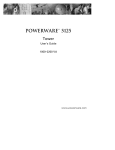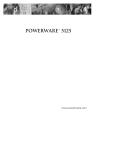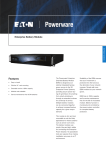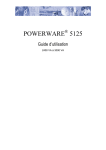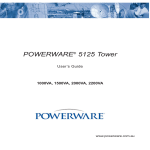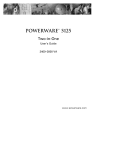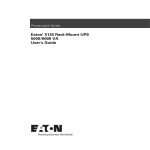Download Dynamix DW - 01/S User`s manual
Transcript
UPS 1000 - 2200 VA User’s Manual Powerware 5125 User’s Manual 1000–2200 VA 1019297 Revision A Table of contents 1. Introduction ............................................................................................................. 7 2. Installation ............................................................................................................... 8 Inspecting the Equipment ............................................................................................ 8 Installing the UPS ......................................................................................................... 8 UPS Rear Panels ........................................................................................................... 9 3. Operation and Configuration .................................................................................. 10 Operating Models ....................................................................................................... 10 Stanby mode ................................................................................................................ 11 Normal Mode .............................................................................................................. 11 Buck and Double Boost Mode .................................................................................... 11 Battery Mode ............................................................................................................... 12 Sleep Mode .................................................................................................................. 12 UPS Configuration ...................................................................................................... 12 Turning the UPS On .................................................................................................... 12 Starting the UPS on Battery ........................................................................................ 12 Turning the UPS Off .................................................................................................... 13 Initiating the Self-Test ................................................................................................. 13 Communication Port .................................................................................................. 13 Network Transient Protector ..................................................................................... 14 Load Segments ............................................................................................................ 15 4. UPS Maintenance .................................................................................................... 16 UPS and Battery Care ................................................................................................. 16 Storing the UPS and Batteries .................................................................................... 16 When to Replace Batteries ......................................................................................... 16 Replacing Batteries ...................................................................................................... 16 Testing New Batteries ................................................................................................. 19 Recycling the Used Battery ......................................................................................... 20 5. Troubleshooting ...................................................................................................... 20 Audible Alarms and UPS Conditions ......................................................................... 20 Silencing an Audible Alarm ........................................................................................ 21 6. Specifications .......................................................................................................... 23 Copyright 2002 The contents of this manual are the copyright of the publisher and may not be reproduced (even extracts) unless permission granted. Every care has been taken to ensure the accuracy of the information contained in this manual, but no liability can be accepted for any errors or omission. The right to make design modifications is reserved. Requesting a Declaration of Conformity Units that are labeled with a CE mark comply with the following harmonized standards and EU directives: • Harmonized Standards: EN 50091-1-1 and EN 50091-2; IEC 950 Second Edition, Amendments A1, A2, A3, and A4 • EU Directives: 73/23/EEC, Council Directive on equipment designed for use within certain voltage limits 93/68/EEC, Amending Directive 73/23/EEC 89/336/EEC, Council Directive relating to electromagnetic compatibility 92/31/EEC, Amending Directive 89/336/EEC relating to EMC The EC Declaration of Conformity is available upon request for products with a CE mark. For copies of the EC Declaration of Conformity, contact: Powerware Oy Koskelontie 13 FIN-02920 Espoo, Finland Phone: +358-9-452 661 Fax: +358-9-452 66 396 Class A EMC Statements (1000–1500 VA Models) FCC Part 15 NOTE This equipment has been tested and found to comply with the limits for a Class A digital device, pursuant to part 15 of the FCC Rules. These limits are designed to provide reasonable protection against harmful interference when the equipment is operated in a commercial environment. This equipment generates, uses, and can radiate radio frequency energy and, if not installed and used in accordance with the instruction manual, may cause harmful interference to radio communications. Operation of this equipment in a residential area is likely to cause harmful interference in which case the user will be required to correct the interference at his own expense. ICES-003 This Class A Interference Causing Equipment meets all requirements of the Canadian Interference Causing Equipment Regulations ICES–003. Cet appareil numérique de la classe A respecte toutes les exigences du Reglement sur le matériel brouilleur du Canada. Special Symbols The following are examples of symbols used on the UPS to alert you to important information: RISK OF ELECTRIC SHOCK - Indicates that a risk of electric shock is present and the associated warning should be observed. CAUTION: REFER TO OPERATOR’S MANUAL - Refer to your operator’s manual for additional information, such as important operating and maintenance instructions. RJ-45 RECEPTACLE - For 230V units only: this receptacle provides network interface connections. Do not plug telephone or telecommunications equipment into this receptacle. This symbol indicates that you should not discard the UPS or the UPS batteries in the trash. The UPS may contain sealed, lead–acid batteries. Batteries must be recycled. 1 Powerware 5125 – Introduction The Powerware® 5125 uninterruptible power system (UPS) protects your sensitive electronic equipment from basic power problems such as power failures, power sags, power surges, undervoltage and overvoltage. Power outages can occur when you least expect it and power quality can be erratic. These power problems have the potential to corrupt critical data, destroy unsaved work sessions, and damage hardware — causing hours of lost productivity and expensive repairs. With the Powerware 5125, you can safely eliminate the effects of power disturbances and guard the integrity of your equipment. The Powerware 5125 was designed for critical applications such as PCs, severs, workstations, and telecommunications equipment. Figure 1 shows the Powerware 5125 UPS with an optional Extended Battery Module (EBM). Figure 1. The Powerware 5125 Providing outstanding performance and reliability, the Powerware 5125’s unique benefits include the following: • Advanced Battery Management Plus (ABM Plus™) doubles battery service life, optimizes recharge time, and provides a warning before the end of useful battery life. • Buck and Double Boost regulation ensures consistent voltage to your load by correcting voltage fluctuations without using battery power. • Hours of extended run time with up to four EBMs. • Hot–swappable batteries simplify maintenance by allowing you to replace batteries safely without powering down the critical load. • Start–on–battery capability allows you to power up the UPS even if utility power is not available. • Advanced power management with the Software Suite CD for graceful shutdowns and power monitoring. • Sequential shutdown and load management through separate receptacle groups, called load segments. • Network Transient Protector guards your network communications equipment from surges. • Optional X-Slot™ modules provide enhanced communication capabilities for increased power protection and control. • The Powerware 5125 is backed by worldwide agency approvals. 1019297 Revision A 1000 - 2200 VA User’s Manual 7 2 Installation Inspecting the Equipment If any equipment has been damaged during shipment, keep the shipping cartons and packing materials for the carrier or place of purchase and file a claim for shipping damage. If you discover damage after acceptance, file a claim for concealed damage. To file a claim for shipping damage or concealed damage: 1) File with the carrier within 15 days of receipt of the equipment; 2) Send a copy of the damage claim within 15 days to your service representative. Installing the UPS The following steps explain how to install the UPS. See “UPS Rear Panels” on page 9 for the rear panel of each model. NOTE Do not make unauthorized changes to the UPS; otherwise, damage may occur to your equipment and void your warranty. 1. If installing an optional EBM, continue to Step 2; otherwise, skip to Step 4. 2. Plug the EBM cable into the battery connector on the UPS rear panel. 3. If a second EBM is to be installed, plug the EBM cable of the second cabinet into the battery connector on the first EBM. Up to four EBMs may be connected to the UPS. 4. If you are installing power management software, connect your computer to the UPS communication port using the supplied communication cable. 5. Plug the detachable UPS power cord, into the input connector on the UPS rear panel. 6. Plug the UPS power cord into a power outlet. The front panel indicators cycle through a startup sequence while the UPS conducts a self–test. indicator flashes, indicating the UPS is in When the self-test is complete, the Standby mode with the equipment offline. If the alarm beeps or a UPS alarm indicator stays on, see Table 2 on page 22. 7. Plug the equipment to be protected into the appropriate UPS output receptacles (see page 15 for more information on load segments). DO NOT protect laser printers with the UPS because of the exceptionally high power requirements of the heating elements. 8. Press and hold the On button until you hear the UPS beep (approximately one second). The indicator stops flashing and the bar graph indicators display the percentage of load being applied to the UPS. The UPS is now in Normal mode and supplying power to your equipment. 8 1000 - 2000 VA User’s Manual 1019297 Revision A NOTE. The batteries charge to 90% capacity in approximately 3 hours. However, it is recommended that the batteries charge for 24 hours after installation or long-term storage. NOTE. If more than two EBMs are installed, an external battery charger is recommended for faster recharge times. Figure 2. Installation UPS Rear Panels This section shows the rear panels of the Powerware 5125 models. Figure 3. PW5125 1000i and PW5125 1500i Rear Panel 1019297 Revision A 1000 - 2200 VA User’s Manual 9 Figure 4. PW5125 2200i Rear Panel 3 Operation and Configuration Operating Modes Powerware 5125’s front panel indicates the UPS status through the UPS indicators. Figure 5 shows the UPS front panel indicators and controls. Figure 5. UPS Front Panel 10 1000 - 2000 VA User’s Manual 1019297 Revision A Standby Mode When the UPS is turned off and remains plugged into a power outlet, the UPS is in Standby mode. The indicator flashes and the bar graph indicators are off, indicating that power is not available from the UPS output receptacles. The battery recharges when necessary. Normal Mode During Normal mode, the indicator illuminates and the front panel displays the percentage of UPS load capacity being used by the protected equipment (see Figure 6). The UPS monitors and charges the batteries as needed and provides power protection to your equipment. Figure 6. Load Level Indicators When all of the bar graph indicators and the indicator are illuminated, power requirements exceed UPS capacity; see page 22 for more information. Buck and Double Boost Mode With the Buck and Double Boost feature, the UPS accepts a wide input voltage range (-30%/+20% of nominal) and provides consistent, clean voltage to your equipment. The UPS operates normally from utility power and alerts you of the voltage fluctuations. indicator alternates between green and red while in Buck, Single Boost, or The Double Boost mode as shown in Figure 7. Figure 7. Buck and Double Boost Indicators 1019297 Revision A 1000 - 2200 VA User’s Manual 11 Battery Mode When the UPS is operating during a power outage, the alarm beeps once every four seconds and the indicator illuminates. When the utility power returns, the UPS switches to Normal mode operation while the battery recharges. indicator flashes and the If battery capacity becomes low while in Battery mode, the alarm beeps twice every two seconds. Immediately complete and save your work to prevent data loss and similar difficulties. When utility power is restored after the UPS shuts down, the UPS automatically restarts. Sleep Mode If the UPS is on battery for approximately five minutes and supporting a small electrical load (≤10%), the UPS shuts down the load. After three minutes in Sleep mode, the UPS initiates a shutdown warning (two beeps every two seconds). This feature conserves battery power. To enable this feature, contact your service representative. UPS Configuration Your PW5125 UPS can be configured by using a configuration software that can be find on web (www.emea.powerware.com/product/PW5125.htm). This software is a DOS based program that can be executed from either a DOS box, from a Windows shortcut, or from the Windows Start, Run dialog box. UPS setting that can be changed are as follow: 1. Voltage setting 220/230/240 V (230 V is factory default) 2. Enable/disable sleep mode (disable as factory default) 3. Enable/disable audible alarm, so that when disable no audible alarms will be given (Enable as factory default) 4. Enable/disable site wiring detection (not supported on European model) Turning the UPS On After the UPS is connected to a power outlet, it conducts a self–test and enters Standby mode. To turn on the UPS, press and hold the On button until you hear the UPS beep (approximately one second). The indicator stops flashing and the bar graph indicators display the percentage of load being applied to the UPS. Starting the UPS on Battery NOTE Before using this feature, the UPS must have been powered by utility power at least once. To turn on the UPS without using utility power, press and hold the On button for at least four seconds. The UPS supplies power to your equipment and goes into Battery mode. 12 1000 - 2000 VA User’s Manual 1019297 Revision A Turning the UPS Off To turn off the UPS, press and hold the Off button until the long beep ceases (approximately five seconds). The indicator begins to flash and the UPS remains in Standby mode until you unplug the UPS from the power outlet. Initiating the Self–Test NOTE. The batteries must be fully charged to perform the self–test. Press and hold the On button for three seconds to initiate the self–test. During the test, individual indicators illuminate as various parts of the UPS are checked. If the alarm beeps or a UPS alarm indicator stays on, see Table 2 on page 22. Communication Port The Powerware 5125 is factory-installed with a Single-Port Module. To establish communication between the UPS and a computer, connect your computer to the UPS communication port using the supplied communication cable. When the communication cable is installed, power management software can exchange data with the UPS. The software polls the UPS for detailed information on the status of the power environment. If a power emergency occurs, the software initiates the saving of all data and an orderly shutdown of the equipment. The cable pins are identified in Figure 8 and the pin functions are described in Table 1. Figure 8. Communication Port Pin Number Signal Name Function Direction from the UPS 1 Low Batt Low Battery relay contact Out 2 RxD Transmit to external device Out 3 TxD Receive from external device In 4 DTR PnP (Plug and Play) from external device (tied to Pin 6) In 5 GND Signal common (tied to chassis) — 6 DSR To external device (tied to Pin 4) Out 7 RTS PnP from external device In / Out 8 AC Fail AC Fail relay contact Out 9 Power Source +V (8 to 24 volts DC power) Out Table 1. Communication Port Pin Assignment 1019297 Revision A 1000 - 2200 VA User’s Manual 13 Network Transient Protector The Network Transient Protector, shown in Figure 9, is located on the rear panel and has jacks labeled IN and OUT. This feature accommodates a single RJ–45 (10BaseT) network connector. Connect the input connector of the equipment you are protecting to the jack labeled IN. Connect the output connector to the jack labeled OUT. Figure 9. Network Transient Protector 14 1000 - 2000 VA User’s Manual 1019297 Revision A Load Segments Load segments are sets of receptacles that can be controlled by power management software, providing an orderly shutdown and startup of your equipment. For example, during a power outage, you can keep key pieces of equipment running while you turn off other equipment. This feature allows you to save battery power. See your power management software manual for details. NOTE. If the power management software is not used, the individual load segments cannot be controlled. The following figures show the load segments for each UPS. Figure 10. 1000 VA and 1500 VA Load Segments Figure 11. 2200 VA Load Segments 1019297 Revision A 1000 - 2200 VA User’s Manual 15 4 UPS Maintenance UPS and Battery Care For the best preventive maintenance, keep the area around the UPS clean and dust–free. If the atmosphere is very dusty, clean the outside of the system with a vacuum cleaner. For full battery life, keep the UPS at an ambient temperature of 25°C . Storing the UPS and Batteries If you store the UPS for a long period, recharge the battery every 6 months by plugging the UPS into a power outlet. The batteries charge to 90% capacity in approximately 3 hours. However, it is recommended that the batteries charge for 24 hours after longterm storage. Check the battery recharge date on the shipping carton label. If the date has expired and the batteries were never recharged, do not use the UPS. Contact your service representative. When to Replace Batteries When the indicator flashes and there is a continuous audible alarm, the batteries may need replacing. Conduct a self–test by pressing and holding the seconds. If the batteries. button for three indicator stays on, contact your service representative to order new Replacing Batteries NOTE DO NOT DISCONNECT the batteries while the UPS is in Battery mode. With the hot–swappable battery feature, UPS batteries can be replaced easily without turning the UPS off or disconnecting the load. If you prefer to remove input power to change the battery: 1) Press and hold the Off button until the long beep ceases (approximately five seconds), then unplug the UPS; 2) Wait 60 seconds while the internal processor shuts down before you disconnect the battery. Consider all warnings, cautions, and notes before replacing batteries. WARNING Batteries can present a risk of electrical shock or burn from high short-circuit current. The following precautions should be observed: 1) Remove watches, rings, or other metal objects; 2) Use tools with insulated handles; 3) Do not lay tools or metal parts on top of batteries. ELECTRIC ENERGY HAZARD. Do not attempt to alter any battery wiring or connectors. Attempting to alter wiring can cause injury. 16 1000 - 2000 VA User’s Manual 1019297 Revision A How to Replace Extended Battery Modules Use the following procedure to replace EBMs: 1. Unplug the EBM cable from the UPS. 2. Replace the EBM. See “Recycling the Used Battery” on page 20 for proper disposal. 3. Plug the new EBM into the UPS as shown in Figure 12. 4. For additional EBMs, plug the EBM cable of the second cabinet into the battery connector on the first EBM. Figure 12. EBM Connections How to Replace Internal Batteries CAUTION Pull the battery out onto a flat, stable surface. The battery is unsupported when you pull it out of the UPS. 1019297 Revision A 1000 - 2200 VA User’s Manual 17 Use the following procedure to replace internal batteries: 1. Remove the UPS front panel by pulling the top. 2. Slide up and remove the metal battery cover. 3. 1000 VA units. Disconnect the red battery cable on the front of the battery. Pull the battery out onto a flat, stable surface. Disconnect the black battery cable on the rear of the battery, then on the front of the battery. Disconnect the red battery cable on the rear of the battery. See “Recycling the Used Battery” on page 20 for proper disposal. 18 1000 - 2000 VA User’s Manual 1019297 Revision A 4. 1500 and 2200 VA units. Pull the battery out onto a flat, stable surface. Press on the black tab on the battery cable connector to disconnect the battery. See “Recycling the Used Battery” on page 20 for proper disposal. 5. Install the new batteries in the reverse order of removal. 6. Reinstall the metal battery cover removed in Step 2. Replace the front panel. Testing New Batteries Press and hold the button for three seconds to initiate a self–test. After the test is finished, the indicator should turn off. If the indicator stays on, check the battery connections. Call your service representative if the problem persists. 1019297 Revision A 1000 - 2200 VA User’s Manual 19 Recycling the Used Battery Contact your local recycling or hazardous waste center for information on proper disposal of the used battery. WARNING Do not dispose of the battery or batteries in a fire. Batteries may explode. Proper disposal of batteries is required. Refer to your local codes for disposal requirements. Do not open or mutilate the battery or batteries. Released electrolyte is harmful to the skin and eyes. It may be toxic. CAUTION Do not discard the UPS or the UPS batteries in the trash. This product contains sealed, lead–acid batteries and must be disposed of properly. For more information, contact your local recycling or hazardous waste center. 5 Troubleshooting Audible Alarms and UPS Conditions The UPS has an audible alarm feature to alert you of potential power problems. Use Table 2 to determine and resolve the UPS alarms and conditions. Figure 13. Alarm Indicators 20 1000 - 2000 VA User’s Manual 1019297 Revision A Silencing an Audible Alarm To silence the alarm for an existing fault, press the button. If UPS status changes, the alarm beeps, overriding the previous alarm silencing. The alarm does not silence if there is a low battery condition. Alarm or Condition Possible Cause Action The indicator is not on; the UPS does not start. The power cord is not connected correctly. Check the power cord connections. The wall outlet is faulty. Have a qualified electrician test and repair the outlet. The indicator is flashing; power is not available at the UPS output receptacles. The UPS is in Standby mode. Press the On button to supply power to the connected equipment.| The UPS does not provide the expected backup time. The batteries need charging or service. Plug the UPS into a power outlet for 24 hours to charge the battery. After charging the battery, press and hold the button for 3 seconds; then check the indicator. If the indicator is still on, see "UPS Maintenence" to replace the battery. The self-test failed Plug the UPS into a power outlet for at least 3 hours to charge the battery. After charging the battery, press and hold the button for 3 seconds; then check the indicator. If the indicator is still on, shut down the UPS and contact your service representative. UPS internal temperature is too high. The UPS shuts down automatically in 10 seconds. Turn off and unplug the UPS. Clear vents and remove any heat sources. Ensure the airflow around the UPS is not restricted. Wait at least 5 minutes and restart the UPS. If the condition persists, contact your service representative. UPS on battery. The UPS is powering the equipment with battery power. Prepare your equipment for shutdown. The battery is running low. 3 minutes or less of battery power remains (depending on load configuration and battery charge). Save your work and turn off your equipment. The alarm cannot be silenced. 1 beep every 4 seconds 2 beeps every 2 seconds Table 2. Troubleshooting Guide 1019297 Revision A 1000 - 2200 VA User’s Manual 21 Alarm or Condition 1 beep every 5 seconds. 100% 25% 22 Possible Cause Action The UPS is running on battery power because the input voltage is too high or too low. Correct the input voltage, if possible. The UPS continues to operate on battery until the conditions is corrected or the battery is completely discharged. If the condition persists, the input voltage in your area may differ from the UPS nominal. The utility line voltage and frequency are out of specification. Have a qualified electrician check the wiring. The battery may be fully discharged. Plug the UPS into a power outlet for 24 hours to charge the battery. After charging the battery, press and hold the button for 3 seconds; then check the indicator. If the indicator is still on, see "UPS Maintenance" to replace the battery. The battery is not connected correctly. Check the battery connections. Call your service representative if the problem persists. Ground wire connection does not exist or the line and neutral wires are reversed in the wall outlet. Have a qualified electrician correct the wiring. Power requirements exceed UPS capacity (101–110% for 3 minutes or 111–150% for 10 cycles) or the load is defective. Turn off and unplug the UPS. Remove some of the equipment from the UPS. Wait at least 5 seconds until all LEDs are off and restart the UPS. You may need to obtain a larger capacity UPS. UPS fault condition. Save your work and turn off your equipment. Turn off and unplug the UPS. Contact your service representative. The alarm cannot be silenced. 1000 - 2000 VA User’s Manual 1019297 Revision A 6 Specifications Model Number Power Levels (rated at nominal inputs) Nominal Voltage PW5125 1000i 1000 VA, 700 W 230 V PW5125 1500i 1500 VA, 1050 W 230 V PW5125 2200i 2200 VA, 1600 W 230 V Input Voltage Range 154-288 V (-30%/+20%) Table 3. Model Specifications Dimensions (W x D x H) Weight 1000 VA Models 162 x 401 x 250 mm 15 kg 1500 VA Models 162 x 467 x 250 mm 23 kg PW5125 2200i 205 x 493 x 250 mm 31 kg Extended Battery Module 162 x 474 x 250 mm 27 kg Table 4. Weights and Dimensions Input Connection Output Receptacles PW5125 1000i 10 A, IEC-320 input connector (6) 10 A, IEC 320-C13 PW5125 1500i 10 A, IEC-320 input connector (6) 10 A, IEC 320-C13 PW5125 2200i 10 A, IEC-320 input connector (9) 10 A, IEC 320-C13 Table 5. Power Connections Operating Frequency 50/60 Hz, auto-sensing Frequency Range 46–65 Hz Noise Filtering MOVs and line filter for normal and common mode noise Regulation (Normal mode) -10% to +6% of nominal voltage Regulation (Battery mode) Nominal output voltage ±5% Voltage Waveform Sine wave Table 6. Technical Specifications 1019297 Revision A 1000 - 2200 VA User’s Manual 23 Operating Temperature 10°C to 40°C Optimal battery performance: 25°C Storage Temperature 0°C to 25°C Transit Temperature -25°C to 55°C Relative Humidity 5–95% noncondensing Operating Altitude Up to 3,000 meters above sea level Transit Altitude Up to 15,000 meters above sea level Audible Noise Less than 40 dBA Normal mode, typical load Less than 55 dBA Battery mode Surge Suppression ANSI C62.41 Category B (formerly IEEE 587), IEC 61000-4-5 UL 1778, UL 497A (data line only); CAN/CSA C22.2, No. 107.1; EN 50091-1-1 and IEC 60950 Safety Conformance Agency Markings UL and cUL; CE, C-Tick, LGA/GS, DEMKO EMC EN 50091-2, FCC Part 15, ICES-003 Table 7. Environmental and Safety 1000 VA: (2) 24V, 9 Ah internal batteries 1500 VA: (4) 48V, 7 Ah internal batteries 2200 VA: (4) 48V, 12 Ah internal batteries Configuration EBM Configuration PW5125 EBM-24: (8) 24V, 9 Ah batteries PW5125 EBM-48: (8) 48V, 9 Ah batteries Type Sealed, maintenance–free, valve–regulated, lead–acid Charging Monitoring Internal battery: less than 3 hours to 90% usable capacity at nominal line voltage after full load discharge External battery: recharging at 80% load or less is recommended; no more than 16x discharge time to 90% usable capacity at nominal line voltage after full load discharge; an external battery charger is recommended for faster recharge times when using more than 2 EBMs. Advanced monitoring for earlier failure detection and warning; auto detection of additional EBMs Table 8. Battery Model Internal UPS Batteries 1 EBM 2 EBMs 3 EBMs 4 EBMs 1000 VA 5/14 45/60 95/170 1500 VA 6/17 33/79 63/146 92/174 120/201 2200 VA 6/14 26/60 55/170 81/198 106/224 NOTE Battery times are approximate and vary depending on the load configuration and battery charge. Table 9. Battery Run Times (in Minutes at Full/Half Load) 24 1000 - 2000 VA User’s Manual 1019297 Revision A
























